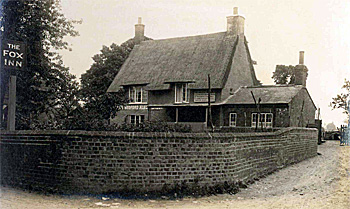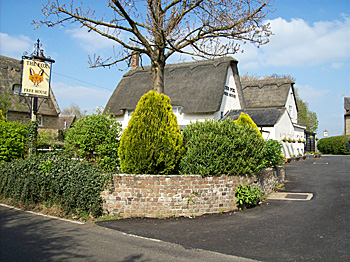The Fox Public House Carlton
This page was written by Pamela Hider

The Fox c.1925. The sign on the wall reads: Archibald C.Wallinger Licensed Retailer for Beer Spirituous Liquors to be drunk on the premises Licensed dealer in tobacco [ref: WL800/2]
The Fox Public House: 35 High Street, Carlton
Early History
The present public house began life as a farmhouse and is referred to in a document of 1732 [ref: GA1302] as a " farmhouse, with orchard and common of pasture, for 2 cows and 6 sheep, in Carlton Moore End Street, lately occupied by Joseph Thomas..." (What is now the High Street was formerly known as Moore End Street or Carlton Street).
By 1768 [ref: WL1000/1/CARL/1/8] it was still a "farmhouse with orchard or pightle and homestead in Carlton in Moor End Street formerly in occupation of Joseph Thomas, now John Emery...", but by 1791 [ref: WL1000/1/CARL/1/2] it was referred to as a "farmhouse in Moor End Street, Carlton with orchard or pightle, homestead and common of pasture for 2 cows and 6 sheep formerly in occupation of Joseph Thomas, then converted into a public house called Fox late in occupation of Allen Church, now of William White". Thus we know the names of the first two occupants of The Fox after its conversion.
By 1809 [ref: WL1000/1/CARL/1/6] we know another - "farmhouse in Moor End Street, Carlton, with pightle and homestead belonging, formerly in occupation of Joseph Thomas, then converted into a public house called Fox in occupation of Allen Church, then William White, now George Lord...."
It will be realised that Occupants are not necessarily Owners. From its conversion to a public house c.1801, the Fox was owned for most of the 19th century by that successful family of brewsters, the Lord family of Olney, Buckinghamshire. When John Lord, its first owner, died in 1812, the pub was held in trust by the trustees of his estate, until the death of his wife Elizabeth in 1846. A document from the Centre for Buckinghamshire Studies [ref: D-BAS/37/754] refers to this and also reveals the name of the Occupant of the Fox in 1818 – Edward Underwood.
The years between 1809 and 1846 [ref: WL1000/1/CARL/1/7] reveal two more occupants: "farmhouse in Moor End Street, Carlton with Pightle and homestead adjoining in occupation of Joseph Thomas, then turned into Fox public house in occupation of Allen Church, then William White, then George Lord, then John Smith, now Thomas Gostick....". In this same document, a John Gostick is referred to as living in a house next to The Fox, but another document, our earliest register of alehouse licences [ref: CL/P13] shows that during the 1820s, he was in fact licensee at The Fox.
Auction at The Fox Inn, Carlton 1834
"Particulars of sale of estates at CARLTON :- Cottage and land. To be sold at the Fox Inn, Carlton, by T. Revis" [ref: GA2098]. 3 closes of land described as arable and pasture; and a cottage, farmyard and buildings,orchard and a close of superior arable land all in Moor End were in the occupation of "Franklin". It would seem they were in the vicinity of The Fox, although the latter was not named.
Assault on a Constable at The Fox 1835
In 1835 Thomas Pettit and Charles Askew were found guilty of assault and sentenced to 21 days hard labour each, a man named William Mole was acquitted. Thomas Pettit, Charles Askew of Odell, labourer, and William Mole of Carlton, tailor, were charged with assaulting William Johnson, constable for the parish of Carlton, in the execution of his duty [ref: QSR1835/3/5/40]. The record reads as follows.
"William Johnson, constable for the parish of Carlton – on Sunday evening 19 April he was sent for as constable to quell a disturbance at the Fox public house at Carlton. When he got there the landlord John Smith asked him to turn out Thomas Pettit who had been breaking the mugs. This was at 8pm. When he took hold of Pettit’s collar Charles Askew said “I should not turn him out”. They all knew he was the constable. He charged his son to assist him. Askew seized his son and by the hair of the head and struck his head against the wall severely. With the help of others they succeeded in turning them out and the landlord locked his door. Soon afterwards a fight took place in the yard between Charles Askew and another person which he tried to stop. Thomas Pettit struck him a severe blow on his head and said “Damn all Constables”. After Pettit struck him he [Johnson] raised his staff to hit him. William Mole snatched it out of his hand and said the two persons fighting should not be parted. Mole was very active in preventing him from interfering to stop the fight".
"William Johnson the younger of Carlton – his father’s statement is true. Charles Askew struck him, Thomas Pettit struck his father and William Mole took the staff out of his hand".
"Thomas Pettit – “I never struck anybody”"
"Charles Askew – “I interrupted no one except a man of Carlton with whom I was fighting"".
"William Mole – he was attracted by the noise and went to see what it was. He did not see Petit strike the constable. He went to assist the constable and did not touch his staff".
"Samuel Tysoe of Turvey, labourer [called on behalf of William Mole] – he went from the meeting at Carlton to the Fox when the row was in the yard. He went into the Fox and had half a pint of beer. He did not see Mr Mole try to take away the staff, but Mr Mole tried to pull away Thomas Pettit who had got hold of Mr Johnson’s staff. Mr Mole told Mr Pettit to give over. [Answering question from the constable] He did not speak to Mr Johnson at the time".
"Simon Knight of Chellington, labourer – he was at the Fox at Carlton when Mr Johnson came. He saw Johnson try to turn out Thomas Pettit and his son assisting him. He did not see anybody hinder Mr Johnson. He saw Mr Mole in the yard just before he went home. He did not see Mole try to take away the staff. He did not see Mr Johnson drink any beer. He saw a pot of beer offered to him several times but did not see him take any".
"William Sabey of Carlton, labourer – he was at the Fox at the beginning of the row. He saw the fight in the yard. All he saw was that Mr Mole was assisting Mr Johnson in trying to get the people quiet. He saw no staff. [Answering question from the constable] He did say to the constable “let them fight”".
The 1890s
An article from The Bedfordshire Mercury, 3rd February 1899, refers to the "DEATH OF MR.GEORGE BULL. - Mr. Bull, landlord of the Fox Inn, died on January 26, aged 51. He had suffered for some years from an internal disease. Previous to Mr. Bull coming to Carlton, he had been a police officer at Harpole, Northamptonshire, where he was much respected, but he had to leave on account of his illness. The funeral took place at the parish church on Sunday afternoon, when a good number of parishioners attended, and the Rector officiated". Mr.Bull's disease must have had an effect on his weight, as there is a tradition that when his body was taken from the Fox, the only way it could be removed from the building was by an upstairs window.
Later History
In 1927, property in Carlton was valued under the Rating and Valuation Act 1925. Every piece of land and building in the country had to be valued to determine the rates to be paid upon it. The valuer visiting the Fox Inn noted that it was owned by Charles Wells Ltd. and the occupier was A.C.Wallinger [ref: DV1/C218/113]. The premises comprised a bar, tap room, parlour and kitchen. Upstairs were 3 bedrooms. Outside was a Barn, Stable for 1, Harness Room and 2 pig sties.
The tied rent was £6 and had been so since 1911. Trade was 1 barrel per week, 3 1/2 dozen bottles per 4 weeks and 3 bottles of spirits per week - next to which the valuer had written "poor little place". He also commented that the bar and tap room were "both small" and that the whole was "small, old fashioned". He recommended "say tied rent £8, 1 barrel £9, bottles & spirits £2" totalling £19.
Our registers show that the owners of The Fox from 1876 to 1891 were Hipwell & Company and after that Charles Wells Limited. But for all the years before then, it was in possession of the Lord family of Olney [Buckinghamshire]. Referring to our Chellington pages, one wonders whether 'Widow Lord' who was licensee of the Chellington Fox in 1759 was part of this family. The last licensee there in our records was at 1785 and perhaps the coming of enclosure at the beginning of the 19th century, which created a new main road and which would have severely curtailed business at the Chellington Fox, marked the end of that inn, so that the Lords opened a new Fox Inn at Carlton.

The Fox Public House, 2017
List of Licensees: note that this is not a complete list; entries in italics refer to licensees where either beginning or end, or both, dates are not known :
1822-1829: John Gostick;
1835: John Smith;
1839-1854: Thomas Gostick;
1861-1867: John Lord;
1869: John Betts;
1876: John Lord;
1881: Thomas Hornby;
1883-1890: Charles Bonfield;
1891-1899: George Bull;
1899-1901: Annie Bull;
1901-1903: John Hopkins;
1903: Richard Giles;
1904: Robert Franklin;
1906-1909: Thomas Quest;
1909-1912: Joseph Swales;
1913-1948: Archibald C.Wallinger;
1949: Annie Wallinger;
1949-1951: Frank Biswell;
1951: F. Gladwin;
1952: Leslie C.West;
1953: William Knight;
1954: Albert S. Hooper;
1955-1956: Ronald Arkey;
1957-1958: Eric Summerfield;
1959: David Kemp;
1960-1961: Catherine A. Kemp;
1962-1974: Dennis W.Warren;
1974-1976: Rodney M. Couzens;
1976-1979: Frederick C. Sparrow;
1979-1984: Malcolm J. Salicki;
1984-1985: Roger M. Pearson;
1985-1992: Alan Fuller;
1992-1993: Andrew R. Peaple;
1993-1996: Patience M. Alexander;
1996-1997: Barbara & Peter Moffatt;
1997-2007: Geraldine & Joseph Goggins;
2008-2013: Alexandra Headland.
List of sources at Bedfordshire Archives:
- GA1302: Conveyance: 1732
- WL1000/1/Carl/1/1-2: Conveyance: 1802
- WL1000/1/Carl/1/5-6: Conveyance: 1809
- GA2098: Auction sale held at the Fox: 1834
- QSR1835/3/5/40: Quarter Sessions depositions: 1835
- WL1000/1/Carl1/9: Administration of William Lord: 1836
- WL1000/1/Carl/1/7: Conveyance: 1846
- WL1000/1/Carl/1/8: Abstract of title: 1846
- WL1000/1/Carl/1/10: Conveyance: 1851
- CL/P19/1: Return of licensed premises: 1876-1891
- WL1000/1/Carl/1/11: Insurance policy: 1883
- CL/P19/2: Return of licensed premises: 1891
- PSS3/1: Register of licences: 1901
- CL/P20: Printed return of licensed rpemises: 1903
- PSS3/2: Register of licences: 1903
- PSS3/3: Register of licences: 1904-1930
- DBV1/25: 1910 Valuation Survey register: 1910
- WL800/2: Photograph: c. 1925
- DV1/C21: 1925 rating and Valuation Act survey: 1927
- Z1521/1: Carlton & Chellington Historical Society Newsletter: June 2008;